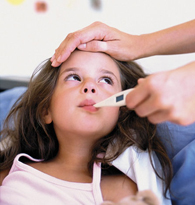Among children below 5 years old, high temperature or fever is considered temperature higher than 37.5 degrees C. It is important to note that fever is quite common in young children.
Fevers are typically triggered by minor viral infections such as common cold or cough and can be readily managed at home. A high temperature can be troublesome to parents, but many children usually recover without any issues after a few days.
How to tell if a child has fever
- Child feels warmer than usual when you touch the forehead, back or stomach
- Child has flushed cheeks
- Child feels sweaty or clammy
Once a child is suspected with fever, the initial step is to check the temperature using a thermometer. You can readily purchase digital thermometers in pharmacies or grocery stores.

How to care for a child with fever
It is important to keep the child comfortable with the following measures:
- Encourage the child to drink plenty of fluids
- Provide the child with food if he/she wants to eat
- Monitor for signs of dehydration such as lack of tears, dry mouth, sunken eyes while a few soiled diapers and sunken fontanelle in infants
- Do not send the child to school until completely well
You can provide the child with paracetamol or ibuprofen if he/she appears distressed. When these medications are given, always check the instructions on the packaging carefully and always stick with the recommended dosage.
In studies conducted, there is no need to sponge the child with tepid water. Just avoid bundling them up in several layers of clothes or blankets.
When to seek further care
If worried about the child, call the doctor. The doctor will ask questions regarding the symptoms experienced by the child. The answers provided will help the doctor decide if the child can be managed at home or when further care is required. If the following are present, seek medical advice:
- The child is below 3 months old and has a temperature reading of 38 degrees C or higher.
- The child is 3-6 months old with a temperature reading of 39 degrees C or higher.
- The child is suspected to be dehydrated
- The child ends up with a red-colored rash that does not seem to fade with glass rolled over it.
- The child could not be reassured and does not stop crying or has a high-pitched, unusual sound while crying.
- Child experiences a fit or convulsion
- The fever lasts for more than 5 days
- The overall health of the child becomes worse
If these are present, it is vital to set an appointment with a doctor so that further assessment can be carried out. The doctor will determine the exact cause of the fever so that proper treatment can be started.
